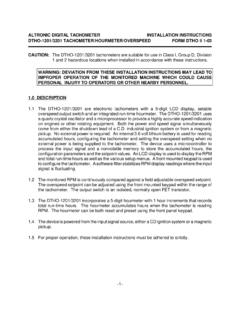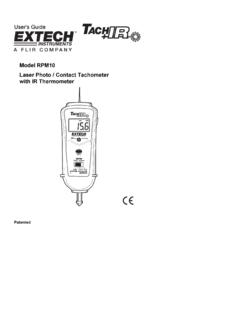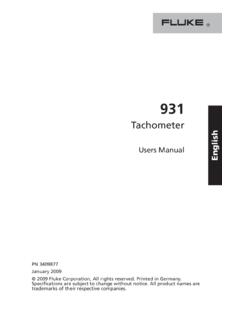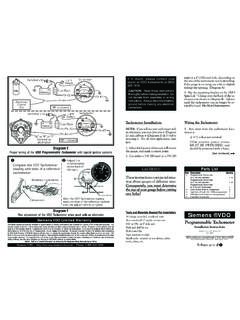Transcription of Smiths Tachometer Conversion d2 - Triumph Car …
1 Page 1 of 10 Smiths & Jaeger Tachometer Conversion Rev. 01 Doug Lawson May, 2005 What is Covered: The following document briefly discusses the operation of tachometers . With that established the document presents the Conversion of Smiths and Jaeger tachometers to accept newer electronic movements. What is Not Covered: The repair of Smiths mechanical and electronic tachometers is not discussed. Information on these operations is available on various Cobra, Lotus, Alpine/Tiger, and MG web sites on the internet. Glossary: A: Mechanical Tachometer . A cable driven instrument connected to the engine to measure its operating speed. B: Current Sensing Tachometer . An electrical instrument where current for the ignition coil passes through the gauge to indicate engine operating speed. C: Voltage Sensing Tachometer : An electrical instrument where a sensor lead is connected to the junction between the ignition coil and the distributor.
2 The gauge monitors the voltage pulses to indicate engine operating speed. Conversion Overview: There are several web sites on the internet which have discussed the Conversion of early Smiths tachometers to a later type. The most common discussion of this topic focuses on the substitution of a later Smiths RVC movement into a gauge originally built for the earlier RVI movement. This allows the owner to maintain a correct appearing dash and have a working Tachometer . This document is written to guide the reader through the steps of converting a Smiths Tachometer to a late model voltage sensing movement or circuit board. A Smiths gauge (or other) may be used as a donor. The reader will be guided through the following operations: 1) Disassembling the Smiths and donor tachometers . 2) Fitting the Smiths gauge face to the donor movement. 3) Fabricating a mounting spacer.
3 4) Fitting a donor circuit board. 5) Simplified calibration. 6) Cosmetic restoration. Mandatory Tools & Supplies: Conversion of a Tachometer will require certain basic tools and supplies. The following is a list of items you must have to complete this process: screwdrivers (Phillips and slotted), hacksaw, knives, wire, wire strippers, solder & soldering iron, drill bits and a drill, taps & screws, scissors, and some form of rigid insulating material (discussed later), and an accurate reference Tachometer for calibration. Optional Tools & Supplies: The Conversion task is greatly simplified if more advanced tools and supplies are available. In addition to the supplies above it will be helpful for the reader to have some or all of the following: a sandblaster, epoxy glue & paint (for cosmetic restoration), a router and bits, access to a milling machine and lathe, a Dremel tool or comparable (with assorted bits), a constant speed motor or spindle, a 12v power supply, assorted industrial sensors, hook up wire, circuit board material, and multi-turn potentiometers.
4 Basic Tachometer Operation: Mechanical tachometers use a rotating magnetic disk in proximity to a spring biased aluminum cup mounted in needle bearings and attached to a pointer (needle). As the magnetic disk is rotated by the drive cable it induces eddy currents in the aluminum cup creating a drag force which rotates the cup against the bias spring. This in turn moves the needle on the gauge face. This is NOT a magnetic coupling. Current sensing tachometers are electrical devices where the current for the engine s ignition coil passes through the instrument. Either on the back of the gauge or inside its housing the sensing wire will be looped into an induction coil or Page 2 of 10 loop. The electronics inside the gauge monitor the pulses on this induction loop and converts them into an electrical signal to move the instrument s needle.
5 Voltage sensing tachometers are electrical devices where a sensor wire is connected to the low side of the ignition coil. During normal operation of the ignition system the voltage on this sensor wire will pulse between ground and the ignition coil s supply voltage. The electronics inside the gauge monitor these pulses and converts them into an electrical signal to move the gauge s needle. Smiths Tachometer Problems: Mechanical tachometers have several failure modes. Obvious areas for failure are the drive gears and cables. In addition to this, the lubrication inside the Tachometer can thicken or harden causing the unit to stop working or wear. Additionally, the interaction of the magnetic disk and the aluminum cup involves a needle bearing which can fail or stick. Once this bearing sticks the pointer is driven all the way around the gauge face ruining the bias spring and driving components together.
6 Once this has occurred the gauge requires professional repair which may not be cost effective. Current sensing tachometers were used on many British cars through the 1960s. Inside the Tachometer are electrical components including electrolytic capacitors which were not designed to last 30 or 40 years. As these older components fail they can be replaced to restore operation but again, this professional repair may not be cost effective. In addition, there is a trend to replace traditional points ignition systems with aftermarket electronic ignitions. For reasons beyond the scope of this document it is often the case that the current sensing tachometers will not work with electronic ignitions. The Smiths tachometers falling into this category can be identified by the letters RVI appearing on the gauge face. Voltage sensing tachometers were used on most cars after the 1960s.
7 Like the current sensing tachometers , inside are electrical components which were not designed to last 30 or more years. As these older components fail they can be replaced to restore operation but again, this professional repair may not be cost effective. The Smiths tachometers falling into this category can be identified by the letters RVC appearing on the gauge face. Repair & Conversion Methods: The upgrading and Conversion of Smiths tachometers falls into two basic categories: 1) Replace the entire Smiths Tachometer (excluding the face) with a later movement ( Smiths or otherwise), or 2) Replace the Smiths Tachometer s electronic circuits while retaining the basic Smiths movement. Which of these two solutions works best must be determined based on the type of Tachometer being converted, the tools and equipment available, as well as the type of donor tachometers available.
8 In the first instance it is necessary to completely gut the old Smiths Tachometer and fit its face and needle to the donor movement. It is typically necessary to fabricate insulated mounting spacers to position the face correctly in the old case. This is the only option when fitting an electronic movement to a Smiths mechanical Tachometer . In the second instance it is necessary to source a small enough donor Tachometer that its circuit board can be easily fitted inside the Smiths case using a minimal amount of custom brackets. In many instances this may prove to be the easier solution. The donor circuit board may come from an existing Tachometer or obtained from a number of internet sources that sell circuits just for this purpose. Parts Sources & Selection: It is assumed that the reader already has a Tachometer in need of repair or Conversion .
9 If not, or if the reader wishes to use a different Tachometer than what is currently in his/her car, they should procure what they need from a suitable source (car clubs, swap meets, online auctions, etc.) The reader should study the gauge in need of service. Measure and record the needle s degree of angular sweep over the face and the maximum reading on the gauge face. One of the most common Smiths /Jaeger Tachometer configurations has a range of 7000 RPM with approximately 270o sweep of the needle. The reader should seek a suitable, voltage sensing, donor Tachometer having the same range and sweep. If the reader cannot obtain a donor Tachometer that matches the sweep and range of the Smiths unit, they should find a donor with MORE sweep for the same maximum RPM ( 7000 RPM with 280o sweep). Alternatively, seek a donor with the same degrees of sweep but with a slightly lower maximum RPM ( 6000 RPM with 270o sweep).
10 Donor tachometers can usually be found at the same sources listed in the previous paragraph. The donor Tachometer may be either a sealed unit from a manufacturer such as Smiths , VDO, AutoMeter, Sun, etc., OR in some instances part of a later car s dash IF the Tachometer is not driven by the donor car s computer. (Unsuitable donor tachometers will NOT have a Tachometer circuit board attached, they will only have the needle movement with connection wires). Page 3 of 10 The reader may wish to disassemble their Smiths Tachometer and make internal measurements of the movement and its case in advance of searching for a donor Tachometer . It is desirable (but not mandatory) to fit the donor Tachometer s electronics inside the smith s case so smaller donor movements are desirable. It should go without saying, that the donor Tachometer should be rated for the same number of cylinders as that of the Smiths unit being replaced.






